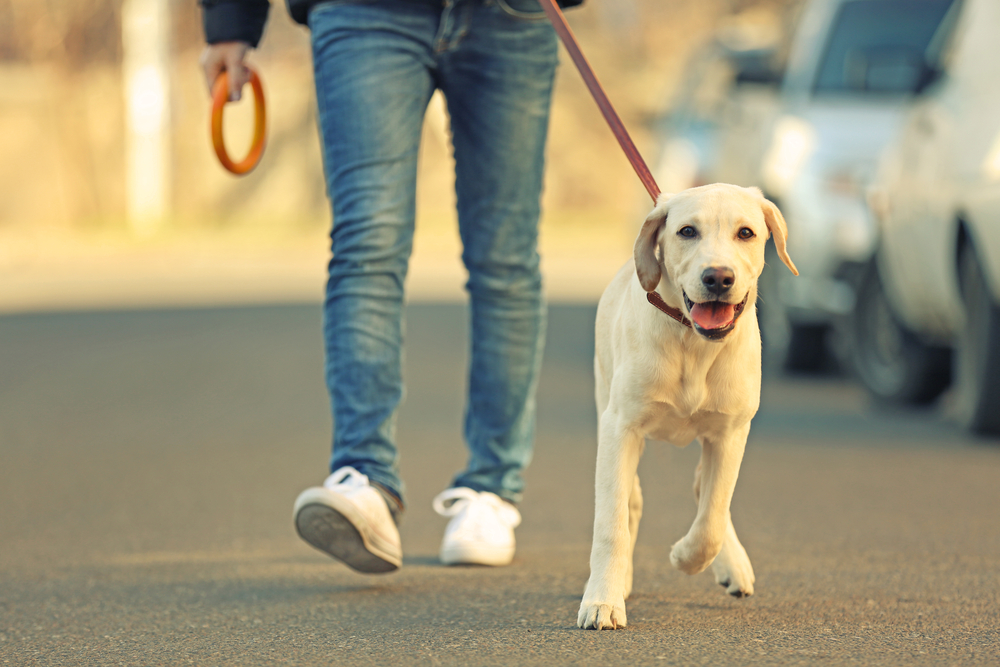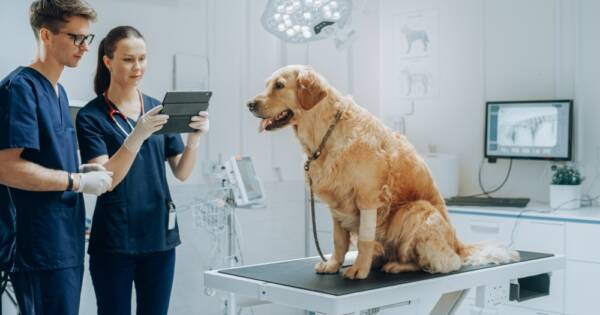Studies have shown that as many as one in five dogs will develop an arthritic condition during their lifetime. While it’s natural for dogs to become less active as they get older, canine arthritis is more serious than simple aging, especially if it goes undiagnosed and untreated.
In total, researchers have identified five different arthritis subtypes that affect dogs. The two most common are degenerative joint disease (a.k.a. osteoarthritis) and inflammatory joint disease. Other, less common forms include metabolic arthritis, which is caused by internal bleeding that affects joints; crystalloid arthritis, which occurs when small crystal-like deposits build up in joints; and neoplastic arthritis, which is a form of joint cancer.
Symptoms of Arthritis in Dogs
Canine arthritis primarily affects older dogs, but it’s important to remember that while rare, it can also develop in young dogs and even puppies. Here are the signs and symptoms to watch for (note: treatment options are listed after the 6 symptoms below):
Symptom: Reduced Activity and Range of Motion
Canine arthritis has a significant impact on your dog’s ability (and desire) to remain active. Dogs with arthritis often seem stiff, especially after extended periods of rest, and often have a hard time getting to their feet from a lying-down position. You may also notice that your dog doesn’t want to or can’t jump during active play, and chances are you’ll also see an overall reluctance to engage in physical activities like running or even regular walking.
Symptom: Changes in Gait
Gait refers to the way your dog walks, and gait changes are an important indicator that arthritis may be developing in your dog. Pets with canine arthritis often start to display a slow gait, and it may seem as though the simple act of walking around the house requires your dog to exert much more effort than it used to.
If your pet’s arthritis is particularly severe in a certain part of its body, you may also notice your dog favoring that part of its body as it walks.
Symptom: Muscle Atrophy
Muscle atrophy is the medical term for muscle loss that results from inactivity. Lay people often call it “wasting away,” as your dog will likely appear gaunt and weakened if atrophy is occurring.
The degenerative nature of arthritis can affect the physical structures of muscles, but the main cause of muscle atrophy in arthritic dogs is inactivity. As the condition worsens and your pet becomes increasingly unable to remain active, its muscle mass will diminish significantly.
Symptom: Weight Changes
Dogs with arthritis often display weight changes, which can include both weight gain and weight loss. Weight gain can occur because your dog is highly likely to be less active as the arthritis continues to impede its ability to stay active. If reduced caloric intake does not accompany this reduced activity, your pet will gain weight.
Weight loss, on the other hand, is usually the result of muscle atrophy. Muscle is denser than fat, and muscle loss can thus result in accelerated weight loss.
Symptom: Loss of Energy
Dogs with arthritis often become lethargic, and it’s often the result of a snowball effect. Arthritis makes dogs less active, and as the dog continues to be less active, it becomes more and more difficult for it to overcome its diminishing energy. Arthritic dogs also tend to sleep much more than healthy dogs of similar ages and breeds.
It’s important for you to prompt your dog to remain as active as possible if it has arthritis, but don’t push your pet too hard or it could injure itself.
Symptom: Personality and Behavioral Changes
The physical symptoms of canine arthritis are often accompanied by changes in behavior and personality. Beyond diminished energy, dogs with arthritis may seem depressed and listless, and they can also become aggressive or anxious. You may also notice your dog licking its joints in an effort to relieve pain and inflammation, and some arthritic dogs also experience a loss of bladder control, leading to indoor “accidents.”
If you see your pet licking its joints, check to see if any swelling is apparent, or touch them (very gently) to see if they feel warm, as both symptoms are associated with canine arthritis.
Treatment of Arthritis in Dogs
Successfully managing canine arthritis will require your dog to make dramatic lifestyle changes. This can pose major challenges, so it’s important to develop a thorough treatment plan with the help of your vet.
Treatment plans typically include one or more of the following:
Treatment Option: Diet and Exercise
Dietary changes may help relieve your pet’s symptoms. Probiotics and sweet potatoes may help ease your pet’s symptoms. Canine nutritionists generally recommend reducing your dog’s intake of fatty meats, as they are believed to make arthritis worse. You can also add omega-3 fatty acids to your dog’s food, while eliminating grain and plant-based oils from your pet’s diet.
Encourage your dog to stay as active as possible, as arthritis symptoms get worse with inactivity. At minimum, you should take your dog out for an easy walk at least once a day.
Treatment Option: Medications
Nonsteroidal anti-inflammatory drugs (NSAIDs) can help relieve arthritis symptoms, which in turn will help your dog remain more active and thus have a better chance at experiencing sustained relief. Injectable steroids may also be recommended, and some veterinarians also endorse the use of a class of drugs known as glycosaminoglycans, which help the body break down the cartilage deposits that can build up around affected joints.
Alternately, your vet may recommend injecting a gel-like solution into your dog’s joints to help keep them nimble and lubricated. In more advanced cases of canine arthritis, a combination of two or more of these drugs may be needed to achieve symptom relief.
Treatment Option: Physical Therapy
Physical therapy isn’t just for people. There are professionals who specialize in physiotherapy for pets, and your vet can help you connect with local specialists that offer this service.
This technique is backed by research. Studies show that physical therapy helps get rid of scar tissue, boost mobility, and reduce the pet’s pain. It can also be combined with complementary therapeutic techniques including massage therapy and chiropractic therapy, both of which can help your dog stay more active without the use of drugs.
Treatment Option: Water Therapy
Water therapy, also known as hydrotherapy, is an excellent zero-impact physical activity for dogs with arthritis. It involves immersing your dog in a pool of water, where it is placed on a treadmill that forces your pet to walk at a suitable pace. This technique is proven to boost your dog’s mobility and help it recover lost range of motion, all while putting absolutely no stress on its bones or joints. It is highly recommended if it is available in your area.
Treatment Option: Surgery
Surgery may be recommended in cases of canine arthritis that result in ligament tears. In most cases, this surgery is performed arthroscopically, which will remove cartilage debris that has built up between your dog’s joints. Once your dog recovers from surgery, it should regain a noticeable amount of its lost range of motion. However, you should be aware that surgery for canine arthritis can be expensive, and it could set you back a bundle if you don’t have health insurance for your pet, or if arthritic surgery isn’t covered by your existing plan.














